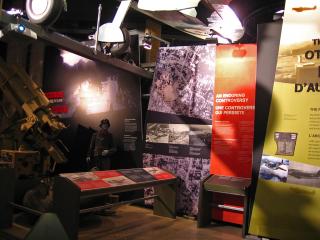Still pondering the controversy about the display in the Canadian War Museum, I decided to go have a look at it first-hand. On the basis of what I saw, I am even more convinced that the display is fair and balanced, and that it should not be altered in response to pressure from veterans.
Here, you can see the panel in question in its immediate surroundings:
This is one small part of a large area discussing the air component of the Second World War. A shot with a narrower field of view shows the controversial panel itself more clearly:
Here is a large close-up shot of the panel text. Nearby, a more prominent panel stresses the deaths of Canadian aircrew and the degree to which aerial bombing “damaged essential elements of the German war effort.” This alternative panel is located right at the entrance to this section of the museum.
If anyone wishes to comment to the museum staff, I recommend emailing or calling Dr. Victor Rabinovitch, the President and CEO. His contact information, along with that of other members of the museum directorate, is available on this page.



While not directly related, I thought this panel on propaganda was interesting.
The little asterix suggests to me that the drafters of the panels anticipated the response: “Surely WE never engaged in propaganda! That is something the wicked regimes did.” and felt like reminding them of what propaganda means.
This article, from back in January, also includes some photos. At that point in time, the museum was not planning to alter the panel.
Here is an article in the Saskatoon Star Phoenix strongly supporting the changing of the display:
“We owe our freedom to Bomber Command vets
Of all those who have gone to war for freedom, none were more courageous than the Canadian bomber crews who helped defeat Nazi Germany. It figures that veterans of that decisive campaign were wounded when the Canadian War Museum — their museum — characterized their effort as immoral and ineffective…”
Are you allowed to post photos from a museum like this?
This is a public taxpayer-funded institution. Furthermore, the photos relate directly to an ongoing public debate. This is a personal, non-commercial site. I think their use is acceptable under several different justifications.
Depressing surrender at war museum
Toronto Star
Secret agents’ memorial unveiled
By Paul Moss
BBC News
It was the SOE that carried out one of WWII’s most famous commando operations, the raid on Telemark.
This destroyed a factory in Norway where the Germans were trying to produce heavy water, an essential ingredient in atomic bombs.
Guest of honour at today’s ceremony was the man who led that raid, Joachim Ronneberg. He was in a sombre mood.
“I am privileged to be here,” he said. “We had lots of friends who never knew that we won the war, because they were killed along the way.
“It’s with great respect that you stand at a memorial like this.”
Bust of Violette Szabo
Violette Szabo gave nothing away under torture
But if members of the SOE faced fierce opposition in the countries where they operated, they also came under attack back in Britain.
Many in the military establishment resented what they regarded as an upstart unit, not under the control either of the generals or of the regular intelligence agencies.
Their methods too were controversial, described euphemistically as “unorthodox,” but condemned by some as downright brutal.
And in some places where the SOE had acted, there were appalling reprisals on the local population.
Some came to doubt whether this civilian death-toll could be justified.
I linked the SOE story above because it involves some of the same tensions.
British people today would probably celebrate the hanging of German spies and saboteurs caught in their territory during WWII, but they also celebrate their fellow nationals doing the same thing in occupied Europe.
WWII may be an unusually clear case of aggression by one side, but I still think this indicates the strange ways in which nationalism affects our thinking about military history.
Giulio Douhet, an Italian general, had argued in 1921 that bombing distant civilian settlements could swiftly ruin a country’s morale. Hugh Trenchard, head of Britain’s nascent Royal Air Force, likewise maintained that aerial bombing could be the key to winning entire wars. He put these conjectures into practice in Iraq, where villages that rebelled against colonial rule were bombed by raf aircraft. “Within 45 minutes”, observed a squadron leader called Arthur Harris in 1924, “a full sized village…can be practically wiped out.” As head of raf Bomber Command, Harris oversaw devastating raids on Hamburg and Dresden during the second world war.
As the exhibition shows, however, such carnage provokes defiance as often as it wrecks morale. “What Remains” includes displays and propaganda videos depicting the ravages inflicted by Islamic State (is) in Mosul and Palmyra. In the end the videos rallied opposition to is; several projects are now restoring what was lost. In 1942 Joseph Goebbels scrambled to present the Baedeker raids, in which Nazi planes attacked historic British towns, as legitimate retaliation rather than gratuitous vandalism.